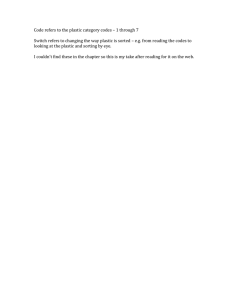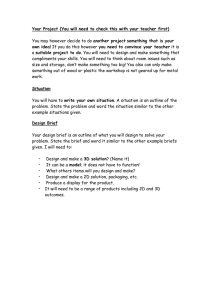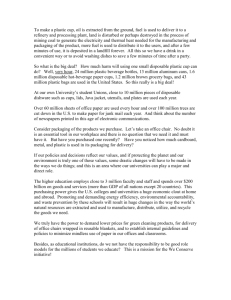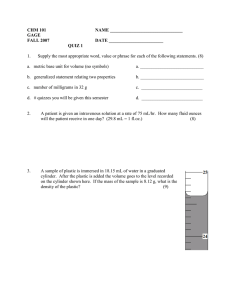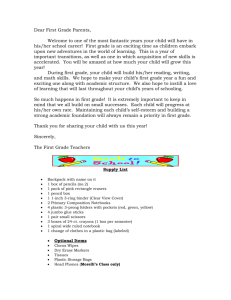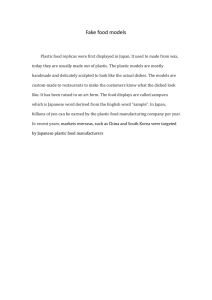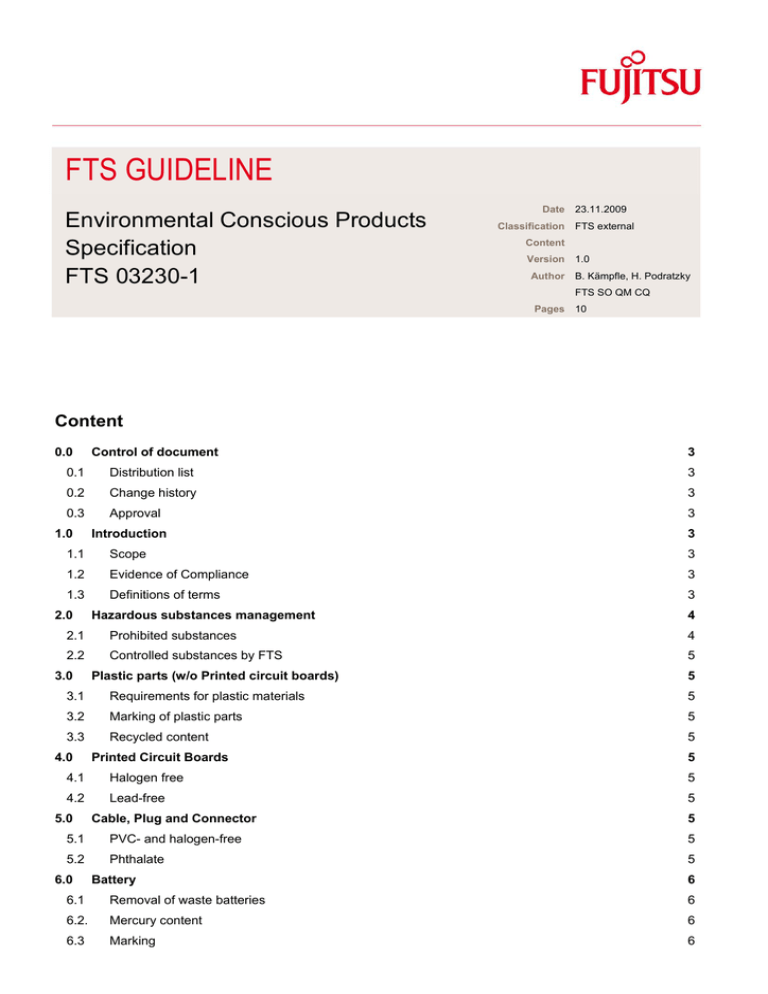
FTS GUIDELINE
Environmental Conscious Products
Specification
FTS 03230-1
Date
Classification
23.11.2009
FTS external
Content
Version
Author
1.0
B. Kämpfle, H. Podratzky
FTS SO QM CQ
Pages
10
Content
0.0 Control of document
3 0.1 Distribution list
3 0.2 Change history
3 0.3 Approval
3 1.0 Introduction
3 1.1 Scope
3 1.2 Evidence of Compliance
3 1.3 Definitions of terms
3 2.0 Hazardous substances management
4 2.1 Prohibited substances
4 2.2 Controlled substances by FTS
5 3.0 Plastic parts (w/o Printed circuit boards)
5 3.1 Requirements for plastic materials
5 3.2 Marking of plastic parts
5 3.3 Recycled content
5 4.0 Printed Circuit Boards
5 4.1 Halogen free
5 4.2 Lead-free
5 5.0 Cable, Plug and Connector
5 5.1 PVC- and halogen-free
5 5.2 Phthalate
5 6.0 Battery
6 6.1 Removal of waste batteries
6 6.2. Mercury content
6 6.3 Marking
6 FTS 03230-1⏐Guideline for Environmental Conscious Products ⏐ Version: 1.0⏐ Date: 23.11.2009
Page 2/10
6.4 Material Safety Data Sheet (MSDS)
6 6.5 Dangerous goods regulations
6 7.0 Printed products information
6 8.0 Packaging
7 8.1 Principal
7 8.2 Marking
7 8.3 Cardboard
7 8.4 Foam plastic (Cushions)
7 8.5 Foil
7 8.6 Wood
7 8.7 Silicate gel bag
8 9.0 Textile
8 10.0 Energy Efficiency
8 10.1 National energy efficiency requirements
8 10.2 Energy Star
8 10.3 Power supply
8 11.0 Mechanical Design
9 12.0 Acoustic
9 13.0 Recycling
9 14.0 Environmental Product Descriptions (EPD)
10 FTS 03230-1⏐Guideline for Environmental Conscious Products ⏐ Version: 1.0⏐ Date: 23.11.2009
Page 3/10
0.0 Control of document
0.1
Distribution list
FTS Intranet
Quality Representatives and MDs
0.2
Change history
Author:
Version:
Date:
Birgit Kämpfle
Harald Podratzky
1.0
23.11.2009
0.3
Change in
chapter
All
Comment
Fully recast of FSC03230
Approval
Name:
Jürgen Wollner
Department/function:
FTS SO QM CQ
Date:
25.11.2009
Signature:
Signature on the original form
The valid version can be found on the Intranet at the following address: http://my.fsc.net/tqm
1.0 Introduction
1.1
Scope
The present specification applies throughout Fujitsu Technology Solutions (FTS).
It describes environmental conscious product requirements around the whole product life cycle for IT products and
components.
This specification is valid for all end user products and electronical assembled components (e.g. optical disk drive,
hard disk drive, power supply, mainboard, add-on cards, etc.).
1.2
Evidence of Compliance
The current valid version of the present guideline is always to use. It is published on the Intranet
http://my.fsc.net/tqm
Compliance to the requirements must be confirmed by using FTS templates, which are available on FTS Intranet:
http://my.fsc.net/testcenter (Ecology).
For ecology certifications (i.e. Blue Angel, Nordic Swan) or country specific requirements, additional confirmations
or special product marking could be necessary.
European regulations are public available on the following Internet link: www.eur-lex.europa.eu/en/index.htm
1.3
Definitions of terms
Plastics
means materials composed of synthetic high-molecular polymers.
Plastic parts
means parts made of plastic material from uniform composition throughout. Printed circuit boards are not
considered as plastic parts.
Biobased (or renewable) plastics
are plastic materials made of raw materials from plant origin.
Postconsumer recycled plastic
means plastic material produced by recycling of waste plastic from used products.
Recycled plastics from process waste
means plastic materials made of decrease in the own production but not from used devices.
FTS 03230-1⏐Guideline for Environmental Conscious Products ⏐ Version: 1.0⏐ Date: 23.11.2009
Page 4/10
Homogeneous material
means a material that cannot be mechanically disjointed into different materials. The term "homogeneous" means
"of uniform composition throughout". Examples of "homogeneous materials" are individual types of: plastics,
ceramics, glass, metals, alloys, paper, board, resins, coatings. The term “mechanically disjointed” means that the
materials can, in principle, be separated by mechanical actions such as: unscrewing, cutting, crushing, grinding
and abrasive processes.
Halogen free
According to the standard IEC 61249-2-21 a material can be classified as halogen-free if it does not contain more
than 0.09 % w/w of chlorine compounds (calculated as chlorine) or not more than 0.09 % w/w bromine compounds
(calculated as bromine) and if the total concentration (chlorine+bromine) does not exceed 0.15 % w/w. This term
applies to polymers provided that comparable materials usually do or did contain chlorine compounds or bromine
compounds. It does not apply to fluorinated polymers such as PTFE (polytetrafluoroethylene) and PVDF
(polyvinylidene difluoride).
Substance
means a chemical element and its compounds in the natural state or obtained by any manufacturing process,
including any additive necessary to preserve its stability and any impurity deriving from the process used, but
excluding any solvent which may be separated without affecting the stability of the substance or changing its
composition;
Preparation
means a mixture or solution composed of two or more substances;
Article
means an object which during production is given a special shape, surface or design which determines its function
to a greater degree than does its chemical composition;
Reuse
means any operation by which WEEE or components thereof are used for the same purpose for which they were
conceived, including the continued use of the equipment or components thereof which are returned to collection
points, distributors, recyclers or manufacturers;
Recycling
means the reprocessing in a production process of waste materials for its original purpose or for other purposes,
but excluding energy recovery
Energy recovery
means the use of combustible waste as a means of generating energy through direct incineration with or without
other waste but with recovery of heat;
Recovery
means any of the applicable operations provided in Annex IIB to Directive 75/442/EEC;
Disposal
means any of the applicable operations provided in Annex IIA to Directive 75/442/EEC;
CAS-Number
CAS registry numbers are unique numerical identifiers for chemical elements, compounds, mixtures and alloys.
They are assigned by the American Chemical Society to every chemical that has been described in the literature.
2.0 Hazardous substances management
Every supplier shall confirm compliance to the requirements in this chapter by using the mentioned templates.
Fujitsu Technology Solutions receives test reports (no older than 6 month) from an ISO 17025 accredited
laboratory for defined regulated substances on request.
2.1
Prohibited substances
The current valid list of prohibited substances is available on the FTS Intranet: http://my.fsc.net/testcenter
All suppliers have to confirm compliance to the list of prohibited substances.
Additionally the supplier has to confirm for all components and products compliance with EU-ROHS by using the
FTS Template, which is available on the FTS Intranet: http://my.fsc.net/testcenter
FTS 03230-1⏐Guideline for Environmental Conscious Products ⏐ Version: 1.0⏐ Date: 23.11.2009
2.2
Page 5/10
Controlled substances by FTS
The current valid “List of hazardous substances to be avoided or declared” is available on the FTS Intranet:
http://my.fsc.net/testcenter
All suppliers have to declare the used substances of the “List of hazardous substances to be avoided or declared”.
3.0 Plastic parts (w/o Printed circuit boards)
3.1
Requirements for plastic materials
Plastic parts shall comply with the “List of Prohibited Substances” as defined in chapter 2.1. Additionally all
materials used in plastic parts have to fulfill the requirements as specified in the “Manufacturer’s Statement of
Plastic Materials” which is available on the FTS Intranet: http://my.fsc.net/testcenter
For plastic parts > 25 g and key caps (even if smaller 25g), the supplier has to confirm the compliance by filling in
and signing the template.
3.2
Marking of plastics parts
Plastic parts > 25 g shall be marked in accordance to ISO 11469:2000 (includes ISO 1043 part 1-4). The Marking
on plastics should be applied to a flat surface that is > 200 mm².
3.3
Recycled content
FTS encourages the suppliers to offer plastic material with a high content of postconsumer percentage (at least
10% by weight).
Plastic parts from renewable/bio based materials would be also preferred.
4.0 Printed Circuit Boards
Printed circuit boards on its own and assembled shall comply with the “List of Prohibited Substances” as defined in
chapter 2.1.
4.1
Halogen free
FTS encourages the suppliers to offer halogen free printed circuit boards (on its own and assembled) in
accordance to the IEC 61249-2-21
(Cl < 0.090 % by weight, Br < 0.090 %; Total (Cl+Br) < 0.15 %).
4.2
Lead-free
All printed circuit boards assembled shall be lead-free soldered, according to EU-RoHS. This requirement also
applies to RoHS-exemption (e.g. Server), wherever possible.
If brominated flame retardants or/and lead is used, then this must be declared in the “List of hazardous substances
to be avoided or declared” (chapter 2.2).
5.0 Cable, Plug and Connector
Cable, plug and connector shall comply with the “List of Prohibited Substances” as defined in chapter 2.1.
If PVC, brominated flame retardants and/or Phthalate are used, then this must be declared in the “List of hazardous
substances to be avoided or declared” (chapter 2.2).
5.1
PVC- and halogen-free
FTS encourages the suppliers to offer PVC and halogen free cables, plugs and connectors in accordance to the
IEC 61249-2-21 (Cl < 0.090 % by weight, Br < 0.090 %; Total (Cl + Br) < 0.15 %).
5.2
Phthalate
FTS requests the supplier to offer cables, plugs and connectors without following Phthalates
• Dibutylphthalate (DBP); CAS-No. 201-557-4
• Bis(2-ethylhexyl)phthalate (Diethylhexylphthalate, DEHP); CAS-No. 204-211-0
• Benzyl butyl phthalate (BBP); CAS-No. 201-622-7
FTS 03230-1⏐Guideline for Environmental Conscious Products ⏐ Version: 1.0⏐ Date: 23.11.2009
Page 6/10
6.0 Battery
Batteries shall comply with the “List of Prohibited Substances” as defined in chapter 2.1.
6.1
Removal of waste batteries
Appliances shall be designed in such a way, that waste batteries can be readily removed. This provision shall not
apply where, for safety, performance, medical or data integrity reasons continuity of power supply is necessary
(e.g. button cell on mainboard).
6.2.
Mercury content
If the mercury content is more than 1 ppm, then this must be declared in the “List of hazardous substances to be
avoided or declared” (chapter 2.2).
6.3
Marking
6.3.1 Capacity
The capacity (Ah/mAh) of batteries shall be indicated on them in a visible, legible and indelible form. Additionally
the Watt-hour-rating of Lithium-Ion-Batteries shall be indicated on them in Wh.
6.3.2
Labeling
Europe
Europe requirements are defined as standard:
Crossed out wheeled bin and chemical symbols (if appropriate) according to EU Directive 2006/66/EC.
www.eur-lex.europa.eu/LexUriServ/LexUriServ.do?uri=OJ:L:2006:266:0001:0014:EN:PDF
www.epbaeurope.net
Other countries
Labeling for other countries shall be applied on request
Japan:
http://www.baj.or.jp/e/environment/index.html
Taiwan:
http://www.baj.or.jp/e/environment/index.html
Thailand: http://www.tisi.go.th/standard/comp_eng.html
China:
http://www.sdrc.gov.cn
http://www.aqsiq.gov.cn
http://www.crc-sepa.org.cn
USA:
http://www.epa.gov/epawaste/conserve/materials/battery.htm#regs
http://www.call2recycle.org
Notice: If a lithium battery of type CR xx is built in the product, the packaging shall be marked with
following text:
“Perchlorate Material – special handling may apply. See www.dtsc.ca.gov/hazardouswaste/perchlorate.”
6.4
Material Safety Data Sheet (MSDS)
Standardized MSDS should be provided for all used batteries.
6.5
Dangerous goods regulations
Some types of batteries are subjects to restrictions for shipment in accordance to the dangerous goods regulations.
The supplier has to consider the specific shipment regulations.
For all types of Lithium batteries the supplier must provide the required information in accordance to the Template
“Manufacturer’s certification for Lithium (Ion) Battery” which is available on the FTS Intranet:
http://my.fsc.net/testcenter
7.0 Printed products information
All products related information should be provided in electronic form, wherever possible.
Used paper shall be chlorine-free bleached and should contain at least 65% postconsumer recycled material.
FTS 03230-1⏐Guideline for Environmental Conscious Products ⏐ Version: 1.0⏐ Date: 23.11.2009
Page 7/10
8.0 Packaging
Packaging materials shall comply with the “List of Prohibited Substances” as defined in chapter 2.1
8.1
Principal
Wherever possible, packaging shall only be made from materials which are environmentally compatible so that
they can be recycled or disposed without difficulty, if the packaging cannot be reused. This means that packaging
is to be produced or procured considering that
• PVC shall not be used as packaging material.
• volume and weight are kept to the minimum required to protect the packed goods.
• reuse or recycling of packaging is possible, and the environmental impact of recycling or disposal of packaging
wastes are minimized.
• the use of harmful and hazardous substances and materials is kept to a minimum. Legal limit values for heavy
metals are to be complied with.
• reusable packaging is given priority after testing and when economical and ecological requirements are
satisfied.
• materials derived from renewable resources are checked for their suitability and used if appropriate (e.g. fibers
as filler or padding).
• the physical properties and characteristics of the packaging material enable recycling for several times under
normal conditions.
• single material packaging is always preferable. This means that the outer and inner packaging should be made
of the same material (e.g. corrugated cardboard, cardboard and paper; polyethylene and polyethylene foam).
• composite packaging (solid materials composed of two or more substances, e.g. foam plastic with corrugated
cardboard) is to be avoided. If composite packaging cannot be avoided, the various materials should be easily
separable (also mechanically).
• adhesive tape, labels, material tags, printing ink, etc., are not allowed to interfere with the reusability or
recyclability of the carrier material: Adhesive materials should conform as closely as possible to the carrier
material or be compatible to same.
8.2
Marking
Following national requirements are defined as standard:
Green dot mark
or
for product packaging
Europe: Material marking in accordance to according to EU Directive 97/129/EC
China: GB18455-2001 Packaging Recycling Marks - The described marking of plastic material in Appendix A is a
generally recognized code of practice. All plastic packaging material shall follow it.
Japan: http://www.meti.go.jp/policy/recycle/main/english/pamphlets/index.html
Korea: http://www.envico.or.kr/language/Eng_new/waste/extend02.jsp
8.3
Cardboard
Cardboard packaging should contain a minimum of 60% postconsumer recycled paper, measured as a percentage
of total cardboard product packaging (by weight), whenever possible.
8.4
Foam plastic (Cushions)
Foam plastic shall not be expanded with ozone depending substances (in accordance to the “List of Prohibited
Substances” in chapter 2.1).
The use of postconsumer recycled plastic would be preferred.
8.5
Foil
The use of postconsumer recycled plastic would be preferred.
8.6
Wood
Wood packaging material made from raw wood must comply to the current valid IPPC Standard ISPM No. 15.
“INTERNATIONAL STANDARDS FOR PHYTOSANITARY MEASURES
Revision of ISPM No. 15
REGULATION OF WOOD PACKAGING ERIAL IN INTERNATIONAL TRADE (2009)”
FTS 03230-1⏐Guideline for Environmental Conscious Products ⏐ Version: 1.0⏐ Date: 23.11.2009
8.7
Page 8/10
Silicate gel bag
Especially for silicate gel bags is the prohibition of Dimethylfumarate (DMF) and Cobald Dicloride to be considered
(in accordance to the “List of Prohibited Substances” in chapter 2.1)
9.0 Textile
The following requirements applies to all textile materials (e.g. bags and accessories), also if it is used in electronic
devices.
Textile shall comply with the “List of Prohibited Substances” as defined in chapter 2.1.
In addition textile materials shall compliant to the Oeko-Tex® Standard 100 Product class II (direct contact with
skin). Certified textile materials would be preferred.
Oeko-Tex® Standard 100: http://www.oeko-tex.com/OekoTex100_PUBLIC/index.asp?cls=02
10.0 Energy Efficiency
10.1
National energy efficiency requirements
All Products shall fulfill the applicable legal standards, especially the following listed regulations.
Notice: Following national regulations are not applicable for Storage Products and Server Class A in accordance to
EN55022:2006.)
Europe:
EuP: all relevant implementing Directives of 2005/32/EC Eco-Design of Energy using Products
Relevant implementing measures:
• EC No 1275/2008 Standby for office equipment (Scope EN 55022:2000 Class B)
• EC No 278/2009 External power supplies for office equipment
In preparation:
• Implementing measure for Computer (Scope Desktops, Notebooks, Workstation, Thin Clients) and Computer
Monitore
• Implementing measure for network standby
Japan:
• Top Runner Program in the latest version http://www.eccj.or.jp/top_runner/index.html
China:
• GB 21520-2008 Minimum Allowable Values of Energy Efficiency and Energy Efficiency Grades for Computer
Monitors
Korea
• e-Standby Power Program: Regulation on Standby Power - Reduction Program
Switzerland
• Energieverordnung http://www.admin.ch/aktuell/00089/index.html?lang=de&msg-id=27628
Australia/ New Zealand
• Minimum Energy Performance Standards (MEPS) http://www.energyrating.gov.au
- in force: Requirements for External Power Supplies http://www.energyrating.gov.au/eps2.html
- in preparation: Requirements for Computer and Computer Monitors
10.2
Energy Star
All Products must be compliant to the current valid Energy Star, at least in one configuration. Exemptions are
allowed for special applications, e.g. Gamer/Multimedia-Computer and for Energy Star product specifications which
are not yet in force. (e.g. Storage Systems).
10.3
Power supply
Internal power supply:
minimum efficiency: 20% load > 82%; 50% load >85%; 100% load > 82%, if not other specified in the component
specification of the internal power supply.
External power supply with max. nameplate output power of 250 W:
The device shall fulfill the current valid Energy Star specification for External Power Supplies.
FTS 03230-1⏐Guideline for Environmental Conscious Products ⏐ Version: 1.0⏐ Date: 23.11.2009
Page 9/10
11.0 Mechanical Design
All products shall be designed for easy disassembly and a high degree of recyclability. This required a modular
construction and the avoiding of metal-matrix composites.
• Components and materials according to Annex II of the EU Directive 2002/96/EC WEEE must be easily
identifiable and removable.
•
• Structure and joining technique:
9 Avoidance of non-separable connections (e.g. glued, welded) between different materials, unless they are
technically required
9 Easily separable mechanical connections between different materials
9 Easy disassembly of devices and components by just one person alone with commonly available tools
9 All plastic parts> 25 g shall be manually separable by one person alone with commonly available tools.
9 Plug/Snap connections between plastic components should be preferred.
9 Screwed connections between components shall be separated with no more than three tools.
• Reduction in the diversity of plastic types
9 The enclosure shall not contain more than two different types of polymers or polymer blends for parts > 25g.
Different plastic parts shall be easily separable from each other.
9 Only one plastic material type shall be used in each plastic enclosure part >100 g.
9 The product shall not contain more than four different types of plastic material for parts > 25g.
•
•
•
•
•
Plastic enclosures shall not contain molded-in or glued-on metal unless metal inserts are easy to remove by
one person alone with commonly available tools. (Notebooks are except)
Plastic parts >25 g shall not be painted or coated, excepted parts from notebooks and accessories.
Painted or coated plastic parts > 100g from notebooks or accessories shall be compatible with recycling or
reuse (including metal coatings).
Plastic parts > 25 g shall be marked in accordance with ISO 11469:2000 (includes ISO 1043 part 1-4). Marking
should also apply to plastics with a flat surface > 200 mm².
Enclosure parts shall be free from electronic modules.
12.0 Acoustic
PCs and Notebooks must at least fulfill the acoustic requirements of both Ecolabel Blue Angel (RAL UZ 78) and
Nordic Swan (Swan-labelling of Personal computers) in the valid version.
Blue Angel (RAL UZ 78): http://blauer-engel.de/en/company/survey_basic_award_criteria.php
Nordic Swan: http://www.svanen.nu/Default.aspx?tabName=CriteriaDetailEng&menuItemID=7056&pgr=48
13.0 Recycling
Electrical and electronic equipment should, wherever possible, be designed to provide for and facilitate its
disassembly, recycling and recovery, and particularly the reuse and recycling of waste electrical and electronic
equipment and its components and substances. (See chapter 11.0 as well)
The design of the appliance shall be made possible for a rate of at least 90 percent of the materials in the product
reusable or recyclable using current infrastructure and technologies.
Electrical and electronic equipment shall be indelibly marked in such a way that the producer is easily identifiable.
Equipment must also be marked with the symbol crossed-out wheeled bin, according to European Standard EN
50419.
Manufacturer shall provide a disassembly instruction that identifies the presence and location of materials that
require special handling, especially nonstandard or new substances or new technologies, and including
components such as batteries.
The WEEE Directive 2002/96 EC requires producer of electrical and electronic equipment to provide recycling
facilities with the information for the correct and environmentally sound treatment of the waste equipment.
To get this information, the OEM/ODM supplier of end user products has to fill in the form “Information for treatment
facilities” which is available on the FTS Intranet: http://my.fsc.net/testcenter
FTS 03230-1⏐Guideline for Environmental Conscious Products ⏐ Version: 1.0⏐ Date: 23.11.2009
Page 10/10
14.0 Environmental Product Descriptions (EPD)
FTS is performing for all end user products “The Eco Declaration (TED)” in accordance to Standard ECMA-370.
Therefore it is required, that the OEM/ODM supplier of end user products has to fill in the form “EPD Template”
which is available on the FTS Intranet: http://my.fsc.net/testcenter
All rights reserved, including intellectual property rights. Technical data subject to modifications
and delivery subject to availability. Any liability that the data and illustrations are complete, actual
or correct is excluded. Designations may be trademarks and/or copyrights of the respective
manufacturer, the use of which by third parties for their own purposes may infringe the rights of
such owner. For further information see ts.fujitsu.com/terms_of_use.html
Copyright © Fujitsu Technology Solutions GmbH 2009
Published by department:
FTS SO QM CQ

